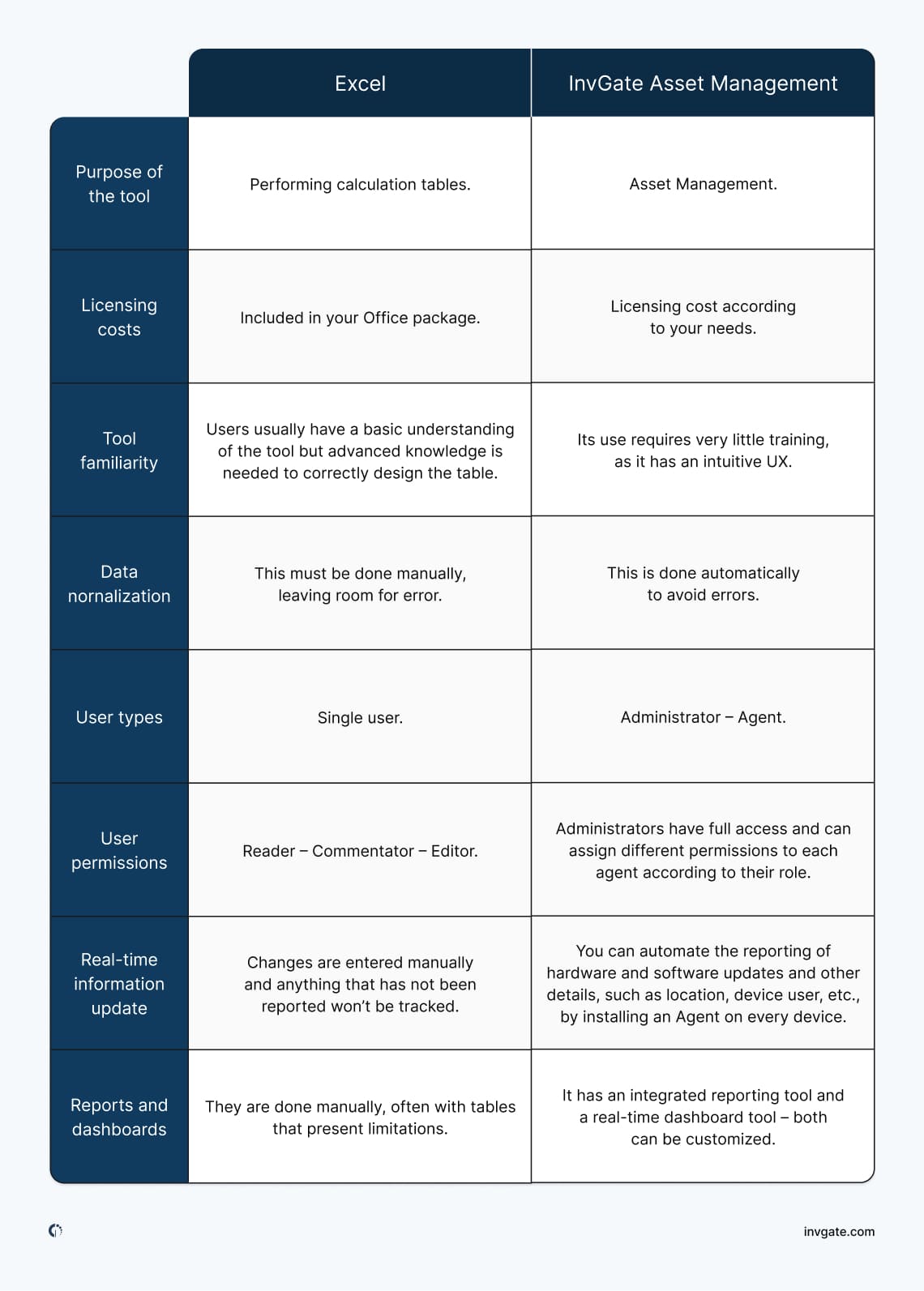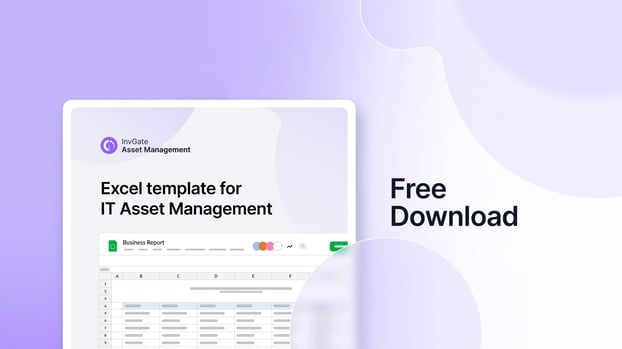Many teams still use Excel for Asset Management. In fact, according to a Gartner study, most businesses rely on manual methods (41%) and spreadsheets (26%) for their day-to-day Inventory Management operations.
With that in mind, in this blog post we’ll explore how to make the most of Excel for Asset Management and offer a template with all the necessary elements to get you started. Finally, we’ll introduce you to InvGate Asset Management and explain why it’s worth considering a solution like this.
How can Excel be used for Asset Management?
Excel can be used for Asset Management by creating a structured table to record key details for each asset — such as type, location, owner, and status — and updating it manually as changes occur.
Why is this a good idea? Because it’s simple, accessible, and (most importantly) a good starting point for tracking assets.
“I still find that Excel is very effective for getting going [...] There's always a starting point.”
Brian Skramstad, ITSM Principal at Allianz Technology
Excel, or any other spreadsheet, is a tool most people are familiar with, and it can serve as a foundation once you’re ready to implement a dedicated tool for managing your assets.
Download an Excel template for Asset Management
To help you get started, we’ve created a ready-to-use template with all the key fields your asset inventory needs. The setup is done for you — just drop in your asset details, and you’ll have a complete, consolidated inventory in minutes.
What to track on an asset tracking spreadsheet?
Now that you’ve downloaded the template, you can see the type of information an IT team should track for every asset. The goal is to capture details that help you know what you have, where it is, who’s using it, and its current state.
In practice, this might mean having columns for things like asset type, manufacturer, location, owner, and warranty expiration. You can also include cost and acquisition date to monitor budgets and plan replacements.
The key is to focus on information that supports decision-making — whether that’s for maintenance, budgeting, compliance, or security. Anything you track should have a clear purpose, not just fill space on a spreadsheet.
Limitations of using Excel for Asset Management
Excel is a great entry point for organizing your assets, but it wasn’t designed for the demands of modern Asset Management. As your organization grows, its limitations become harder to ignore. Here’s where spreadsheets often fall behind.
#1: They only give you a static view
A spreadsheet shows your asset inventory at a single point in time. Once it’s created, every change (from a new device being added to an old one being retired) has to be entered manually.
This means your data can become outdated quickly, making it harder to make accurate, timely decisions that rely on a real-time view of your environment.
#2: No real-time monitoring
If a laptop goes offline, software needs an update, or an unauthorized device appears on your network, Excel won’t flag it. You’d only find out when you manually check — or when a problem escalates.
Without automatic monitoring, issues that could have been addressed early can turn into downtime, security incidents, or compliance breaches.
#3: Limited accuracy and traceability
Manual entry invites errors: typos, duplicate entries, and missing information are common in spreadsheets. Over time, these small mistakes can snowball into unreliable data.
And since Excel doesn’t offer detailed edit histories or granular permissions, it’s hard to track who made changes and when — a problem during audits or investigations.
#4: Complex license tracking
Excel can store license information, but it can’t actively track usage, expirations, or compliance requirements. This means renewals can be missed, unused licenses can go unnoticed, and you may even risk failing a vendor audit.
Any of these scenarios can result in unnecessary costs or penalties — expenses that often outweigh the cost of a dedicated Asset Management tool.
#5: No built-in automation
Every update, report, or maintenance reminder in Excel has to be done manually. This takes time, increases the workload for your IT team, and leaves more room for human error.
In environments with many assets, the lack of automation makes it difficult to keep information current and processes efficient.
#6: Hard to scale
As your organization grows, so does the complexity of your asset inventory. Large spreadsheets are harder to maintain, more prone to corruption, and slower to share securely.
Eventually, the effort needed to keep them accurate outweighs their convenience — making them a bottleneck for your IT operations.
Replacing the IT Asset Management Excel template with ITAM software

By now, it’s clear that spreadsheets are a good way to start tracking assets, but they can’t match the accuracy, efficiency, and scalability that modern Asset Management demands. The good news? Moving from Excel to InvGate Asset Management is seamless.
If you already have your inventory in our Excel template (or any other spreadsheet) you can import it directly into InvGate Asset Management in just a few clicks. The platform supports .csv and .xls files, requires no coding, and is intuitive enough for both technical and non-technical teams.
Once your data is in, the benefits go far beyond what Excel can offer:
- Centralized, up-to-date inventory – Keep all your hardware, software, and non-IT asset records accurate and in one place.
- Multiple discovery methods – Automatically populate your inventory through agent-based discovery, network scans, manual entries, and integrations.
- Asset Lifecycle Management – Plan, deploy, maintain, and retire assets with real-time health and performance monitoring to catch issues early.
- Automation – Eliminate repetitive manual updates with automated alerts, scheduled reports, and lifecycle actions.
- Smarter budgeting and compliance – Plan purchases and replacements with accurate data while managing contracts and licenses to avoid overspending and penalties.
- Custom reports and dashboards – Get actionable insights without manual spreadsheet work.
- Better security and compliance – Reduce vulnerabilities and stay audit-ready by keeping assets updated, monitored, and traceable.
With InvGate Asset Management, you gain more control over your assets — and with more control comes less risk, fewer penalties, and a smoother IT operation overall.
The best part? You can try it free for 30 days. Just upload your current inventory, and in minutes you’ll have a live, centralized system that grows with your organization.















